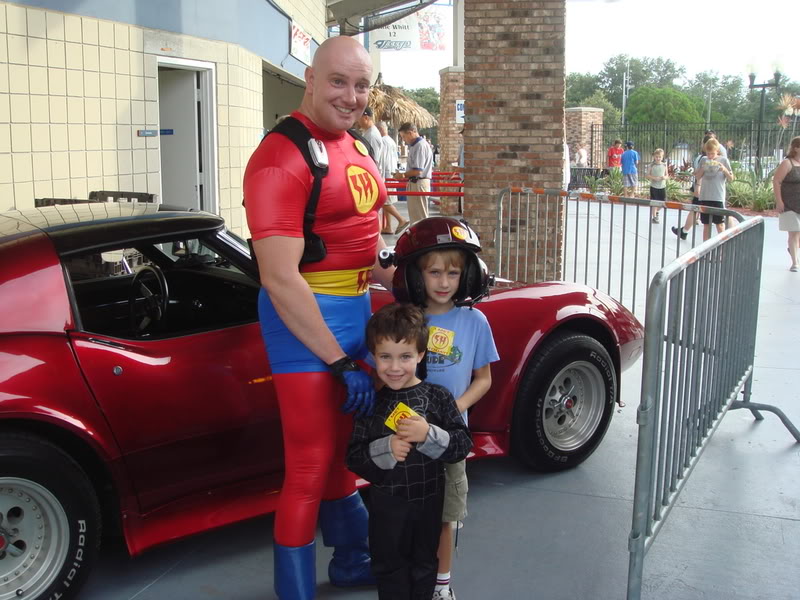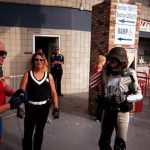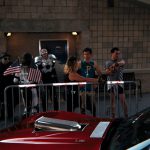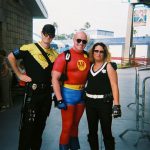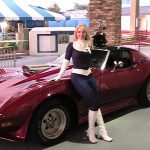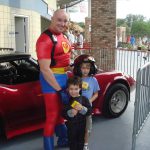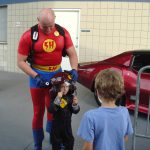It's a Bird! It's a Plane! It's…Some Dude?!
They are ordinary men in extraordinary costumes, and they have risen from the ashes of our troubled republic to ensure the safety of their fellow citizens. Jon Ronson goes on patrol with Urban Avenger, Mr. Xtreme, Pitch Black, Knight Owl, Ghost, and the baddest-ass “real-life superhero” of them all, Phoenix Jones
I am rushing to the emergency room to meet a real-life superhero called Phoenix Jones, who has fought one crime too many and is currently peeing a lot of blood. Five nights a week, Phoenix dresses in a superhero outfit of his own invention and chases car thieves and breaks up bar fights and changes the tires of stranded strangers. I’ve flown to Seattle to join him on patrol. I landed only a few minutes ago, at midnight on a Friday in early March, and in the arrivals lounge I phoned his friend and spokesman, Peter Tangen, who told me the news.
“Hospital?” I said. “Is he okay?”
“I don’t know,” said Peter. He sounded worried. “The thing you have to remember about Phoenix is that he’s not impervious to pain.” He paused. “You should get a taxi straight from the airport to there.”
At 1 a.m. I arrive at the ER and am led into Phoenix’s room. And there he is: a young and extremely muscular black man lying in bed in a hospital smock, strapped to an IV, tubes attached to his body. Most disconcertingly, he’s wearing a full-face black-and-gold rubber superhero mask.
“Good to meet you!” he hollers enthusiastically through the mouth hole. He gives me the thumbs-up, which makes the IV needle tear his skin slightly. “Ow,” he says.
His 2-year-old son and 4-year-old stepson run fractiously around the room. “Daddy was out fighting bad guys in his super suit, and now he has to wait here,” he tells them. Then he makes me promise to identify neither them nor his girlfriend, to protect his secret identity.
He looks frustrated, hemmed in, fizzing with restless energy. “We break up two or three acts of violence a night,” he says. “Two or three people are being hurt right now, and I’m stuck here. It bothers me.”
By “we” he means his ten-strong Seattle crew, the Rain City Superheroes. A few hours ago, they were patrolling when they saw a guy swinging a baseball bat at another guy outside a bar. “I ran across the street, and he jabbed me in the stomach,” he says, pointing at a spot just below his belly button. “Right under my armor.”
Unfortunately the head of the bat landed exactly where he’d been punched a week earlier by another bar brawler holding a car key in his fist. That attack had burst a hole right through Phoenix’s skin.
“A few hours ago I went to use the bathroom and I started peeing blood,” he says. “A lot of it.”
I glance over at Phoenix’s girlfriend. “There’s no point worrying about it,” she says with a shrug.
Finally the doctor arrives with the test results. “The good news is there’s no serious damage,” he says. “You’re bruised. Rest. It’s very important that you go home and rest. By the way, why do you name a pediatrician as your doctor?” “You’re allowed to stay with your pediatrician until you’re 22,” Phoenix explains.
We both look surprised: This big masked man, six feet one and 205 pounds, is barely out of boyhood.
“Go home and rest,” says the doctor, leaving the room.
Phoenix watches him go. There’s a short silence. “Let’s hit the streets!” he hollers. “My crew is out there somewhere. I’ll get suited up!”
···
“I got tired of people doing things that are morally questionable,” he says. “Everyone’s afraid. It just takes one person to say, ‘I’m not afraid.’ And I guess I’m that guy.”
The robber had left his mask in the car, so Phoenix picked it up and made his own mask from it. “He used the mask to conceal his identity,” he says. “I used the mask to become an identity.”
He called himself Phoenix Jones because the Phoenix rises from the ashes and Jones is one of America’s most common surnames: He was the common man rising from society’s ashes.
It’s 2:30 a.m. by the time we reach his very messy apartment, where he quickly changes into his full superhero costume: a black-and-gold rubber suit complete with stab plates and a pouch for his Taser and Mace. “It’s bulletproof,” he tells me.
We head downtown and park in the business district, a bunch of empty office buildings in a nice part of Seattle. Other than some junkies and drunks wandering around like zombies, the place is deserted. We see neither his crew nor any crime.
“How are you feeling?” I ask.
“I’m in a lot of pain,” he says. “The cut’s still bleeding, internally and externally. A couple of my old injuries are flaring up, like some broken ribs. I’m having a rough night.”
“Maybe you’re going too hard,” I say.
“Crime doesn’t care how I feel,” he replies.
Just then a young man approaches us. He’s sweating, looking distressed. “I’ve been crying, dude!” he yells.
He’s here on vacation, he explains. His parents live a two-hour bus ride away, in central Washington, and he’s only $9.40 short for the fare home. “I’ve asked sixty people,” he pleads. “Will you touch my heart, save my life, and give me $9.40?”
Phoenix turns to me. “You down for a car-ride adventure?” he says excitedly. “We’re going to drive the guy back to his parents!”
The young man looks panicked. “Honestly, $9.40 is fine…,” he says, backing away slightly.
“No, no!” says Phoenix. “We’re going to drive you home! Where’s your luggage?”
“Um, in storage at the train station…,” he says.
“We’ll meet you there in ten minutes!” says Phoenix.
Thirty minutes later: the train station. The man hasn’t showed up. Phoenix narrows his eyes. “I think he was trying to scam us,” he says, looking genuinely surprised.
Does this guilelessness make him delightfully naive, I wonder, or disturbingly naive? He is, after all, planning to lead me into some hazardous situations this weekend.
At 4 a.m. we finally locate his crew on a corner near the station. Tonight there’s Pitch Black, Ghost, and Red Dragon. They’re all costumed and masked and, although in good shape, smaller and stockier than Phoenix. He stands tall among them and does most of the talking, too. They’re monosyllabic, as if deferring to their leader.
This is what the superheroes are talking about:
Knight Owl: I’ve discovered a maskmaker who does these really awesome owl masks. They’re made out of old gas masks.
Phoenix: Like what Urban Avenger’s got?
Knight Owl: Sort of, but owl-themed. I’m going to ask her if she’ll put my logo on it in brass.
Phoenix: That’s awesome. By the way, I really like your color scheme.
Knight Owl: Thank you. I think the yellow really pops.
We’re ten feet away now. The superhero chatter ceases, and the only sound is the squeak of my luggage wheels as I roll them down the street. Up close, these dealers and addicts look exhausted, burnt-out.
Leave them alone, I think. Haven’t they got enough to deal with? They’ll be gone by the time any daytime people wake up. Why can’t they have their hour at the bus stop? Plus, aren’t we prodding a hornet’s nest? Couldn’t this be like the Taco Incident times a thousand?
The Taco Incident. Ever since Phoenix appeared on CNN in January in a short segment extolling his acts of derring-do, the superhero community has been rife with grumbling. Many of them, evidently jealous of Phoenix’s stunning rise, have been spreading rumors. The chief gossips have been N.Y.C.’s Dark Guardian and Seattle’s Mr. Raven Blade. They say Phoenix is not as brave as he likes people to believe, that he’s in it for personal gain, and that his presence on the streets only serves to escalate matters. To support this last criticism, they cite the Taco Incident.
Phoenix sighs. “It was a drunk driver. He was getting into his car, so I tried to give him a taco and some water to sober him up. He didn’t want it. Eventually he got kind of violent. He tried to shove me. So I pulled out my Taser, and I fired some warning shots. Then the police showed up….”
“I didn’t realize he was a drunk driver,” I said. “The other superheroes implied it was just a regular random guy you were trying to force a taco onto. But still—” I gesture at the nearby crack dealers—”the Taco Incident surely demonstrates how things can inadvertently spiral.”
“They’re in my house,” he resolutely replies. “Any corner where people go, that’s my corner. And I’m going to defend it.”
We walk slowly past the bus stop. Nothing happens. Everyone just mutters angrily at one another.
It is now 5 a.m. Our first night’s patrolling together ends. I’m glad, as I found that last part a little frightening. I am not a naturally confrontational person, and I’d really like to check into my hotel and go to bed.
···The real-life-superhero movement began, the folklore goes, back in 1980, when someone by the name of the Night Rider published a book called How to Be a Superhero. But the phenomenon really took hold a few years later when a young man from New Orleans (whose true identity is still a closely guarded secret) built a silver suit, called himself Master Legend, and stepped out onto the streets. He was an influential if erratic inspiration to those that followed.
“Ninety percent of us think Master Legend is crazy,” Phoenix told me. “He’s always drinking. He believes he was born wearing a purple veil and has died three times. But he does great deeds of heroism. He once saw someone try to rape a girl, and he beat the guy so severely he ended up in a hospital for almost a month. He’s an enigma.”
So what happened next? How did the RLSH movement grow from one visionary in Louisiana to 200 crusaders and counting? Well, the rise of the mega-comic conventions has certainly helped. I remember a friend, the film director Edgar Wright (Shaun of the Dead, Scott Pilgrim vs. the World), returning from his first San Diego Comic Con saucer-eyed with tales of hitherto reclusive geeks wandering around in elaborate homemade costumes, their heads held high. “It was like Geek Pride,” he said.
The community continued to blossom post-September 11 and especially during the recession of the past few years. Inspired by real-life-superhero comic books like Watchmen and Kick-Ass, both of which became movies, RLSHs have been cropping up all over the place. There’s no national convention or gathering, but Peter Tangen is doing all he can to make them a cohesive community with a robust online presence.
···The morning after my first night with Phoenix, I have coffee at a downtown Seattle café with Knight Owl, a former graphic designer who joined the movement because “I wanted something more with my life.” He tells me about common rookie mistakes, such as adopting a superhero name that’s already in use. “It’s a general faux pas—anything with the words night, shadow, phantom… Those dark-vigilante-type-sounding names tend to get snapped up pretty fast.”
“Have there been any other Knight Owls?” I ask.
“There was an Owl,” he says. “The Owl. But he ended up changing his name to Scar Heart, since he’d had a heart transplant.”
He says he chose his name before he knew there was a Nite Owl in the Watchmen comic, so when people online tell him, “You’re a fucking pussy, and by the way, Knight Owl’s taken—haven’t you seen Watchmen?” they don’t know what they’re talking about.
The second rookie mistake is to “get caught up in the paraphernalia. People should think more about the functionality.”
“I assume capes aren’t functional,” I say, “because they can get snagged on things.”
“If you’re going to do some serious crime fighting, there’d better be a good reason for a cape,” he nods. “And grappling hooks—no, no, no, no, no! What? You think you’re going to scale a building? What are you going to do when you get up there? Swoop down? Parachute down? You’re not going to have enough distance for the parachute to even open.”
Knight Owl seems to regard Phoenix as the real thing in a community rife with wannabes. That’s how Phoenix sees himself, too. When I asked him why he seems to be capturing the public’s imagination in a way that the other RLSHs haven’t, he attributes it to his bravery. Others, he says, talk the talk but in reality just hand out food to the homeless and would probably run shrieking from danger if they ever chanced upon it.
“When you wake up one day and decide to put on spandex and give out sandwiches, something’s a little off,” Phoenix says. “I call them real-life sandwich handlers.”
“I know exactly what you mean,” I say. “I was once at a Halloween party and I didn’t take off my mask all night. It completely eliminated all social anxiety.” “Sometimes I wish I never had to take the mask off,” says Urban Avenger.
We begin our patrol through the clean, well-to-do streets of downtown San Diego. We pass bars and clubs filled with polite-looking young drinkers. A few take pictures of the superheroes on their phones. Others yell, “It isn’t Halloween anymore!” from car windows. Urban Avenger says he doesn’t understand how Phoenix is forever chancing upon crimes being committed. He’s just lucky.
“What are the odds?” he sighs. “I almost never see anything.” He pauses. “Last October we got involved in breaking up some street fights.”
“Five months ago?”
“It’s been really quiet around here ever since.”
He says Phoenix is fortunate to have the scary district of Belltown on his doorstep. “Google ‘gunshots in Belltown’ and you’ll come up with a hundred stories of gunshots being fired in, like, the last year,” he says wistfully.
Some boys pass us. “Want some reefer? Ganga? Weed?” they say, sotto voce.
“No,” says Urban Avenger, walking quickly on. The boys shrug and continue on their way.
“Good thing I got all that on video,” Urban Avenger eventually calls after them, indicating a small camera attached to his shoulder.
“Crack? Heroin? PCP?” the boys call back.
“Did you really film it?” I ask.
“No,” he says.
“I noticed you didn’t attempt a citizen’s arrest,” I say.
“We didn’t have probable cause,” explains Mr. Xtreme. “All they did is say something. If they’d shown us crack rocks or marijuana, it might have been a different story.”
“You could have said you wanted to buy some, and then they’d have produced the drugs and you could have arrested them,” I say.
There’s a short silence. “That’s true,” says Urban Avenger.
···Back in Seattle, we start our second patrol at 1 a.m. on Saturday night. Phoenix is in a bad way. He’s still ailing from the key-punching and the baseball-bat incidents and has now developed a fever of 102.5.
“I found out this morning I have tetanus,” he tells me.
“You have to sleep,” I say.
“No sleeping for us,” says Phoenix.
I’m starting to like Phoenix a lot. For all his naïveté, there’s something infectiously upbeat about him. He’s forever cheerful and positive and energetic. I ask him if he’s addicted to crime fighting, and he says, “I guess you could put it in the addiction category. It’s the highlight of my day. Addictions are normally detrimental to health. This is detrimental to my health.”
He puts his positive spirit down to a stable home life: “I’ve been with my girlfriend since I was 16. I make my own money. To be a successful superhero, you’ve got to have your life in line.”
We begin in Pioneer Square. We’re a small team tonight; Pitch Black and Ghost are Phoenix’s only companions. The bars are closing, and drunk kids are piling onto the streets, but there’s still a frustrating absence of crime. But then, from somewhere up the street, we hear a shout: “I’m going to fuck you, bitch.”
Phoenix screeches to a halt. “I’ll be right with you guys!” he calls to us. He poses for the girl.
“Phoenix!” I sigh.
The real-life superheroes like to portray their motives as wholly benevolent, but if they were driven purely by altruism, they’d have become police officers or firefighters or charity volunteers. Something else is evidently propelling them—a touch of narcissism. It’s an odd sort of narcissism, of course, when the narcissist disguises his face, but the lust for fame and glory is unmistakable. By the time Phoenix has had his picture taken, the potential criminal and victim are nowhere to be seen.
Two uneventful hours pass. By 3 a.m. we are losing hope. Phoenix is reduced to suggesting we rent a hotel room, phone some prostitutes, and ask them on their arrival if they need help escaping the web of prostitution.
“I think the problem with the plan,” I say, “is if a prostitute turns up at a hotel room and sees three men in masks, she’s not going to immediately think ‘superhero.’ Plus, she may have to travel all the way across Seattle. It’ll be an hour out of her night.” They agree to abandon the idea.
Suddenly we notice a man across the street drop a small, clear bag on the ground at the feet of another man.
“Yahtzee!” yells Phoenix. He rushes across the road. “What did you just drop?”
“Pretzels,” says the man, picking the bag up and showing it to us.
There’s a silence. “Good,” says Phoenix.
···Our very last hope is Belltown. When we turn the corner into the district, everything changes. By day this place is nice: art galleries, bars, restaurants. It’s just down the road from the famous Pike Place Market. But now, at 4 a.m., the two or three blocks in front of me look as menacing and desperate as the projects from The Wire. The dealers staring at us look nothing like the exhausted old crackheads from the bus stop. These are large gangs of wiry young men. They stand on every block. The police are nowhere to be seen. I take in the scene and instinctively take a small step backward.
“There’s a possibility we could get into a fight,” whispers Pitch Black. “If that happens, back off, okay?”
“What are you doing?” a man calls from across the street, outside a shuttered-up liquor store.
“Patrolling,” Phoenix calls back. “What are you doing?”
He, Pitch Black, and Ghost walk toward him. He’s with eight other men.
“You’ve got to respect people’s block, man,” the guy is saying. “You don’t come down here with your ski masks on. What are you doing, getting yourselves entwined in people’s lives? You guys are going to get hurt. You understand? You want to see our burners?”
“I don’t care,” says Phoenix.
“You don’t care?”
“Not really. I’ve already been shot once.”
“I’ve been shot three times!” another guy says, looking weirdly proud. “One motherfucker round here got shot in the nighttime. Innocent bystanders get shot here. Think about the bigger picture. You’re putting your lives on the line. If you guys are in a casket, your mamas are going to be like, ‘For what?‘ ”
“Don’t be a hero,” a third man adds. “That superhero shit? You’re going to get hurt, fucking around. How you feed your family is not how we feed our family. We’re not out here for the fun and the show-and-tell. This is real life.”
I am finding myself ostentatiously nodding at everything the crack dealers are saying, I suppose in the hope that if the shooting starts, they’ll remember my nods and make an effort to shoot around me.
“I appreciate the info,” says Phoenix.
Suddenly the first guy takes a step forward and peers at Phoenix through his mask.
“You’re a brother?” he says. “You’re a BROTHER and you’re out here looking like THIS? You’ve got to be out of your fucking mind, man.”
And then it all changes. “I feel threatened right now,” the guy says. “You’ve got ski masks on. I don’t know if you’re trying to rob me. A guy got shot last Friday in Belltown by somebody with a mask on. Is that you?”
“You don’t have to be here,” says Phoenix. “You’ve got choices.”
“I’ve been in the system since I was 10 years old!” he yells. “I haven’t got no choices! When your kids get older, this is going to be the same shit.”
“I disagree,” says Phoenix.
“It can’t be better!” the man yells. “This is it!”
The dealers withdraw up the block to decide what to do next.
“Have a good night,” calls Phoenix. “Good meeting you.”
···They’re watching us, murmuring to one another. Their problem is that nobody wants to buy crack in front of three men dressed as superheroes. While Phoenix and his crew stand here, they’re losing all their business.
Phoenix points to two packs of cigarettes under the windshield wiper of a nearby car.
“Those are indications that you can buy here,” he says. “So I’m going to take them off and annoy the crap out of them.”
He scrunches the packets up and throws them onto the sidewalk.
At this, one of the gang heads toward us. If you were watching from across the road, it would seem as if he just wanders past, but in fact he whispers something as he does: “You keep staying on our block, we gonna have to show you what the burner do.”
“Thank you, it’s great meeting you,” says Phoenix.
The man loops and rejoins the others.
The streets are deserted, and it’s starting to feel exceedingly dangerous. It’s just the dealers and their guns and us. But then, miraculously, a taxi passes. I flag it. The superheroes all have (supposedly) bulletproof vests. I have a cardigan. “I’ll give you $20 to just stay here,” I say to the driver.
He looks around. “No,” he says.
“Thirty dollars?”
And then, suddenly, the whole gang, all nine of them, some with their hands down their trousers as if they’re holding guns just under their waistlines, walk toward us. I can’t see much of Phoenix under the suit, but I can see by the way his hands are shaking that he is terrified.
“My shift is over,” calls the taxi driver. “I need to go home now.”
“Forty dollars!” I yell. “Just stay there!”
“I don’t care about the money!” the driver yells. But he doesn’t move.
The men get closer.
“Are we leaving or are we standing?” says Phoenix.
“We’re standing,” says Ghost.
“We’re standing,” says Pitch Black.
“You’re willing to die for this shit?” the first guy, who seems to be the leader, is yelling. “You’re willing to DIE for this shit? You guys are dumb motherfuckers. I don’t even know what to say. You guys are fucking stupid.” He stares at Phoenix. A moment passes. This is what I imagine a standoff feels like the instant before the shooting starts. But then his voice softens. “If you guys are going to stand here and die for it, I guess we’re going to have to walk home. We should shoot your ass, but I guess we’ve got to go home.”
And they do. They disperse. They go home.
Stunned, I look at Phoenix. He suddenly seems smaller than six feet one, lighter than 205 pounds, younger than twentysomething. “You won!” I tell him.
“They had the weapons, the numbers, but they backed down to the image of Phoenix Jones,” he says.
I feel an impulse to celebrate with him, but suddenly the full weight of the evening comes crashing down on me.
“I’m going to bed,” I say.
“We’ll stand here for ten minutes and solidify the corner,” he replies. “You don’t want to stand with us?”
“Definitely not,” I say.
I jump into the taxi. And when I arrive back at the hotel, my legs buckle and I almost fall onto the floor.
···Five a.m. My phone rings. It’s Phoenix, shrieking with laughter, babbling, hyperventilating, releasing all the adrenaline.
“That was ridiculously intense! In a few hours, I’ve got to be a day-care worker!”
···It’s the next afternoon. There’s a comic convention in town, at the Washington State Convention Center in the business district. There are something like 30,000 people here, families and costumed comic fans, packing the modern glass building. I spot Knight Owl and another Seattle superhero named Skyman. He is only semicostumed. He’s unmasked and goateed, and he’s wearing a white T-shirt with a Skyman logo of his own design.
“This place,” I tell Knight Owl, “is full of costumed people who would never confront drug dealers in the middle of the night. You and Phoenix and Skyman exist in some shadow world between fantasy and reality.”
“Yeah,” Knight Owl replies. “What we do is hyperreality!”
And then there are cheers and gasps and applause: Phoenix Jones has arrived. He is a superstar here. He sees me and we hug—two brave warriors who have been through a great adventure together.
“Thank you for making our city safe!” a woman in the crowd calls out to him.
“You’re a very cool man!” someone else shouts.
I tell Phoenix it is time for me to leave.
“When you write this, be sure to tell everyone that what we do is dangerous,” he says.
“I think you’re great,” I say. “But I’m worried you’re going to get yourself killed.”
“Well, don’t make it seem like I’d be dying for a choice,” he replies. “I couldn’t quit if I wanted. You know how many people in this city look up to me? I haven’t paid for my own coffee in six months.”
And I suddenly realize I feel about Phoenix the same way everyone here does. I think he is an awesome superhero.
As I walk out, I hear a father whisper to his young son, “That’s a real superhero.”
“Are you a real superhero?” the little boy asks Phoenix.
Phoenix looks down at him and smiles.
“I’m as real as you can get.”

















